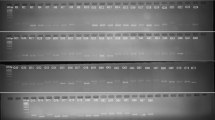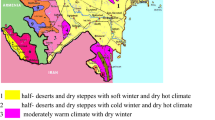Abstract
A population of 105 wheat genotypes (including 94 hexaploid and 11 tetraploid genotypes) was used to determine genetic diversity. Samples were grown based on the randomized complete block design with three replications under salinity stress (120 mM NaCl (and control (10 mM NaCl (conditions. Morpho-physiological traits associated with tolerance of salinity at the seedling stage were recorded. The results of the analysis of variance showed that there were significant differences between genotypes in all studied traits, except K+/Na+ ratio. The amount of potassium content of leaves and roots in control was higher than salt stress conditions. Salinity significantly decreased all traits measured except Na+ concentration in root and shoot and leaf stomata conduction. A total of 12 SSR (simple sequence repeats) markers were assessed for the existence of polymorphism between genotypes. The highest Nei (Nei 1973) gene diversity was observed for gwm410 (0.72) and gpw2181 (0.71) markers, and PIC (polymorphic information content index) values ranged from 0.2 to 0.67. According to PIC, only six markers were informative during this study. These markers could be more efficient in displaying the genotypic differentiation of the near-wheat species as they showed the highest genetic diversity. Simple regression analysis showed that barc212 marker had the most significant relationship with root dry weight, leaf moisture and stomatal conductance (at 0.01 significant level). The gpw2181 marker showed a significant correlation with different traits under stress conditions. It was suggested that this marker could be used for marker-assisted selection to improve salt stress tolerance of wheat.

Similar content being viewed by others
Explore related subjects
Discover the latest articles and news from researchers in related subjects, suggested using machine learning.Data Accessibility
The datasets supporting this article have been uploaded as part of the Supplementary Material.
References
Agrama HA, Tuinstra MR (2003) Phylogenetic diversity and relationships among sorghum accessions using SSRs and RAPDs. Afr J Biotech 2:334–340. https://doi.org/10.5897/AJB2003.000-1069
Ahmad M, Shahzad A, Iqbal M, Asif M, Hirani AH (2013) Morphological and molecular genetic variation in wheat for salinity tolerance at germination and early seedling stage. Aust J Crop Sci 7(1):66
Arif Y, Singh P, Siddiqui H, Bajguz A, Hayat S (2020) Salinity induced physiological and biochemical changes in plants: an omic approach towards salt stress tolerance. Plant Physiol Biochem 156:64–77. https://doi.org/10.1016/j.plaphy.2020.08.042
Ateş Sönmezoğlu Ö, Terzi B (2018) Characterization of some bread wheat genotypes using molecular markers for drought tolerance. Physiol Mol Biol Plants: Int J Funct Plant Biol 24(1):159–166. https://doi.org/10.1007/s12298-017-0492-1
Atlassi Pak V, Bahmani O (2019) Comparison of chlorophyll content of wheat cultivars (Triticum aestivum L.) different in sodium shoot concentration under salinity stress. J Environ Stresses Crop Sci 12(2):579–588
Azadi A, Mardi M, Majidi Hervan E, Mohammadi SA (2014) QTL mapping of yield and yield components under normal and salt-stress conditions in bread wheat (Triticum aestivum L.). Plant Mol Biol Report 33:102–120. https://doi.org/10.1007/s11105-014-0726-0
Batool N, Ilyas N, Shahzad A, Hauser BA, Arshad M (2018) Quantitative trait loci (QTLs) mapping for salt stress tolerance in wheat at germination stage. Pak J Agric Sci 55(1):47–55
Botstein D, White R, Skolnick M, Davis R (1980) Construction of a genetic linkage map in man using restriction fragment length polymorphisms. Am J Hum Genet 32(3):314–331
Cuin TA, Parsons D, Shabala S (2010) Wheat cultivars can be screened for NaCl salinity tolerance by measuring leaf chlorophyll content and shoot sap potassium. Funct Plant Biol 37:656–664. https://doi.org/10.1071/FP09229
Decagon-Devices (2016) Leaf porometer. Operator’s Manual. 2365 NE Hopkins Court Pullman WA 99163. Version: October 17 P 17. https://www.etesters.com/catalog/9BEDF543-E851-482E-B3A8-B12AC87BCBBE/decagon-devices-inc/
Dehnavi AR, Zahedi M, Ludwiczak A, Cardenas SP, Piernik A (2020) Effect of salinity on seed germination and seedling development of sorghum (Sorghum bicolor L. Moench)genotypes. Agronomy 10(6):859. https://doi.org/10.3390/agronomy10060859
Ebrahimi A, Naghavi MR, Sabokdast M, Moradi AS (2011) Association analysis of gronomic traits with microsatellite markers in irainian barley landraces barley. Mod Genet J 6:35–43
Edet OU, Gorafi YSA, Nasuda S et al (2018) DArTseq-based analysis of genomic relationships among species of tribe triticeae. Sci Rep 8:16397. https://doi.org/10.1038/s41598-018-34811-y
Eslami A, Rahiminejad M, Saeidi H (2012) Study the correlation between genetic diversity and geographical distance among triticum species in Iran using molecular markers. Conference. In: The 17th and 5th International Iranian Biology Conference. At: Kerman Iran Vol 17
FAO (2015) FAO cereal supply and demand brief . http://www.fao.org/worldfoodsituation/csdb/en/ [last accessed 05 January 2016]
Flowers TJ, Munns R, Colmer TD (2015) Sodium chloride toxicity and the cellular basis of salt tolerance in halophytes. Ann Bot 9:1–13. https://doi.org/10.1093/aob/mcu217
Gao L, Jia J, Kong X (2016) A SNP-based molecular barcode for characterization of common wheat. PLoS ONE 11(3):e0150947. https://doi.org/10.1371/journal.pone.0150947
Gholizadeh A, Dehghani H, Dvorak J (2014) Inter-relationships between chlorophyll content and seed yield in bread wheat under saline conditions. Iran J Field Crop Sci 45(4):625–638
Giraldo P, Benavente E, Manzano Agugliaro F, Gimenez E (2019) Worldwide research trends on wheat and barley: a bibliometric comparative analysis. Agronomy 9(7):352. https://doi.org/10.3390/agronomy9070352
Guo J, Yu X, Yin H, Liu G, Li A, Wang H et al (2016) Phylogenetic relationships of thinopyrum and triticum species revealed by SCoT and CDDP markers. Plant Syst Evol 302:1301–1309. https://doi.org/10.1007/s00606-016-1332-4
Gupta PK, Rustgi S, Kulwal PL (2005) Linkage disequilibrium and association studies in higher plants: present status and future prospects. Plant Mol Biol 57:461–485. https://doi.org/10.1007/s11103-005-0257-z
Hall G (2015) Pearson’s correlation coefficient. http://www.hep.ph.ic.ac.uk/~hallg/UG_2015/Pearsons
Hoagland DR, Arnon DI (1950) The water-culture method for growing plants without soil. California Agricultural Experiment Station, Circular-347
Kamran Khan M, Anamika Pandey A, Thomas G, Akkaya MS, Kayis SA, Ozsensoy U, Hamurcu M, Gezgin S, Topal A, Hakki EE (2015) Genetic diversity and population structure of wheat in india and turkey. AoB Plants 7:plv083. https://doi.org/10.1093/aobpla/plv083
Krawczak M, Nikolaus S, von Eberstein H, Croucher PJP, El Mokhtari NE, Schreiber S (2006) PopGen: population-based recruitment of patients and controls for the analysis of complex genotype-phenotype relationships. Public Health Genomics Community Genet 9:55–61. https://doi.org/10.1159/000090694
Li DZ, Gao LM, Li HT, Wang H, Ge XJ, Liu JQ et al (2011) Comparative analysis of a large dataset indicates that internal transcribed spacer (ITS) should be incorporated into the core barcode for seed plants. Proc Natl Acad Sci USA 108:19641–19646. https://doi.org/10.1073/pnas.1104551108
Liu K, Muse S (2005) Power marker: an integrated analysis environment for genetic marker analysis. Bioinformatics 21:2128–2129. https://doi.org/10.1093/bioinformatics/bti282
Moradkhani H, Mehrabi A, Etminan A, Pour Aboughadareh A (2015) Molecular diversity and phylogeny of triticum-aegilops species possessing D genome revealed by SSR and ISSR markers. Plant Breeding and Seed Science 71:81–95. https://doi.org/10.1515/plass-2015-0024
Munns R (2008) Tester M (2008) Mechanisms of salinity tolerance. Annu Rev Plant Biol 59(1):651–681. https://doi.org/10.1146/annurev.arplant.59.032607.092911
Munns R, James R, Gilliham M, Flowers TJ, Colmer TD (2016) Tissue tolerance: an essential but elusive trait for salt-tolerant crops. Funct Plant Biol 43:1103–1113. https://doi.org/10.1071/FP16187
Nei M (1973) Analysis of gene diversity in subdivided populations. Proc Natl Acad Sci 70(12):3321–3323. https://doi.org/10.1073/pnas.70.12.3321
Petersen G, Seberg O, Yde M, Berthelsen K (2006) Phylo-genetic relationships of triticum and aegilops and evidence for the origin of the A, B, and D genomes of common wheat (Triticum aestivum). Mol Phylogenet Evol 39:70–82. https://doi.org/10.1016/j.ympev.2006.01.023
Raveendar S, Lee GA, Lee KJ, Shin MJ, Kim SH, Lee JR, Cho GT, Hyun DY (2019) DNA barcoding for efficient identification of triticum subspecies: evaluation of four candidate loci on phylogenetic relationships. Plant Breed Biotech 7(3):220–228. https://doi.org/10.9787/PBB.2019.7.3.220
Ren Y, Xu Y, Gui X, Wang S, Ding J, Zhang Q, Ma Y, Pei D (2012) QTLs analysis of wheat seedling traits under salt stress. Scientia Agricultura Sinica 45(14):2793–2800. https://doi.org/10.3864/j.issn.0578-1752.2012.14.002
Rohlf FJ (1993) NTSYS-pc: numerical taxonomy and multivariate analysis system, version 1.8 Exeter Software, Setauket, New York
Saddiq MS, Afzal I, Basra SM, Iqbal Sh, Ashraf M (2020) Sodium exclusion affects seed yield and physiological traits of wheat genotypes grown under salt stress. J Soil Sci Plant Nutr 20:1442–1456. https://doi.org/10.1007/s42729-020-00224-y
Saeidi H, Rahiminejad MR, Vallian S, Heslop Harrison JS (2006) Biodiversity of diploid D-genome aegilops tauschii Coss. in Iran measured using microsatellites. Genet Resour Crop Evol 53:1477–1484. https://doi.org/10.1007/s10722-005-7110-8
Sairam RK, Tyagi A (2004) Physiology and molecular biology of salinity stress tolerance in plants. Current Science 86(3): 407–421. http://www.jstor.org/stable/24108735
Salehi M, Arzani A, Talebi M, Rokhzadi A (2018) Genetic diversity of wheat wild relatives using ssr markers. Genetika 50(1):131–141. https://doi.org/10.2298/GENSR1801131S
Senguttuvel P, Raveendran M, Vijayalakshmi C, Thiyagarajan K, Kannan Bapu JR, Viraktamath BC (2010) Molecular mechanism of salt tolerance for genetic diversity analyzed in association with Na+/K+ ratio through SSR markers in rice (Oryza Sativa L.). Int J Agric Res 5(9):708–719. https://doi.org/10.3923/ijar.2010.708.719
Slim A, Piarulli L, Chennaoui Kourda H, Rouaissi M, Robbana C, Chaabane R, Pignone D, Montemurro C, Mangini G (2019) Genetic structure analysis of a collection of tunisian durum wheat germplasm. Int J Mol Sci 20(13):3362. https://doi.org/10.3390/ijms20133362
Tahernezhad Z, Zamani MJ, Solouki M, Zahravi M, Imamjomeh AA, Jafaraghaei M, Bihamta MR (2010) Genetic diversity of iranian aegilops tauschii coss. using microsatellite molecular markers and morphological traits. Mol Biol Rep 37:3413–3420. https://doi.org/10.1007/s11033-009-9931-6
Thomas KG, Bebeli PJ (2010) Genetic diversity of greek aegilops species using different types of nuclear genome markers. Mol Phylogenet Evol 56(3):951–961. https://doi.org/10.1016/j.ympev.2010.04.041
Xu B, Waters Sh, Byrt C, Plett D, Tyerman S, Tester M, Munns R, Hrmova M, Gilliham M (2017) Structural variations in wheat HKT1;5 underpin differences in Na+ transport capacity. Cell Mol Life Sci 5(6):1133–1144. https://doi.org/10.1007/s00018-017-2716-5
Yildirim E, Taylor AG, Spittler TD (2006) Ameliorative effects of biological treatments on growth of squash plants under salt stress. Sci Hortic 111:1–6. https://doi.org/10.1016/j.scienta.2006.08.003
Zhou H, Xie Z, Ge S (2003) Microsatellite analysis of genetic diversity and population genetic structure of a wild rice (Oryza rufipogon Griff.) in china. Theor Appl Genet 107:332–339. https://doi.org/10.1007/s00122-003-1251-y
Zhu M, Shabala L, Cuin TA, Huang X, Zhou M, Munns R, Shabala S (2016) Nax loci affect sos1-like Na+/H+ exchanger expression and activity in wheat. J Exp Bot 67(3):835–844. https://doi.org/10.1093/jxb/erv493
Acknowledgements
The authors wish to thank the Seed and Plant Improvement Institute in Karaj for providing seeds of wheat genotypes in this research.
Author information
Authors and Affiliations
Contributions
FS made significant contributions to the phenotyping and genotyping experiments, investigating, phenotypic data analysis, research sponsor and writing and compilation of article. AA made significant contributions to the conceptualization and design, genotypic and phenotypic data analysis, writing of article. KS participated in the investigating and phenotyping experiments and writing manuscript. CM participated in the investigating and phenotyping experiments and writing manuscript. GM participated in the investigating, collecting the data and revising the article.
Corresponding author
Ethics declarations
Conflict of interests
The authors declare that they have no conflict of interests.
Supplementary Information
Below is the link to the electronic supplementary material.
Rights and permissions
About this article
Cite this article
Farhangian-kashani, S., Azadi, A., Khaghani, S. et al. Association analysis and evaluation of genetic diversity in wheat genotypes using SSR markers. BIOLOGIA FUTURA 72, 441–452 (2021). https://doi.org/10.1007/s42977-021-00088-y
Received:
Accepted:
Published:
Issue Date:
DOI: https://doi.org/10.1007/s42977-021-00088-y




